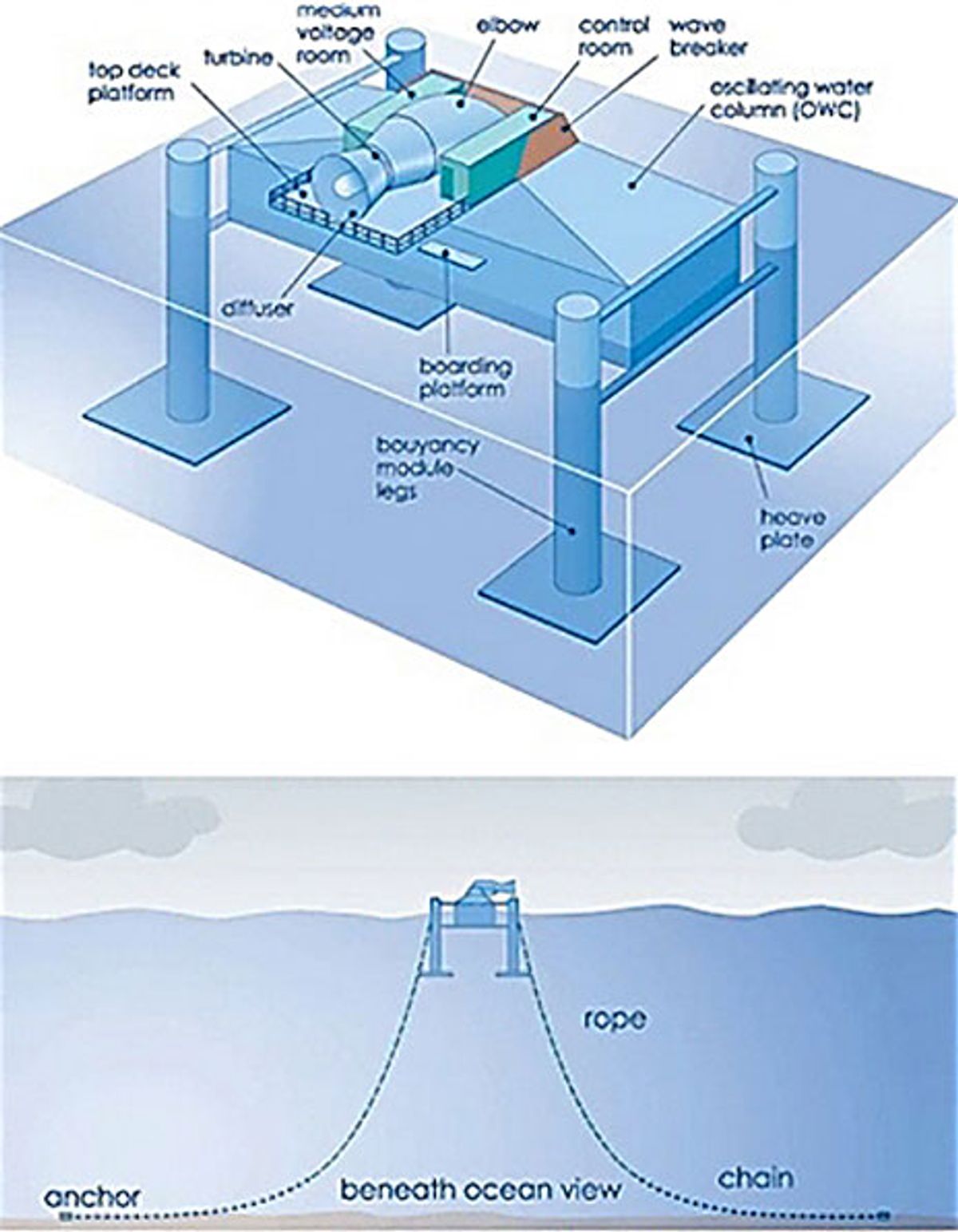20 October 2009—The ocean is a potential treasure trove for renewable energy—one NASA study estimated more than 91 000 terawatt-hours annually of accessible energy worldwide. But wave-power technology development has been plagued by the unpredictability of the source and technical troubles stemming from the harsh ocean water environment. Now an Australia-based company has found a new way, to predictably and reliably generate energy from the ocean. The technology relies on the power of ocean swells, which are easy-to-predict long-wavelength oscillations.
Earlier this month, off the coast of Port Kembla, near Sydney, Oceanlinx began installation of its final demonstration-scale, grid-connected unit before it begins commercial construction. (The company is disassembling its first demo plant there, which has been in operation since 2006.) The new plant will be ready in early 2010, and its power can be connected to the Australian grid. Oceanlinx CEO Ali Baghaei says the new plant ”will validate a capacity over 2.5 megawatts” per unit—enough energy for about 2000 Australian homes.
The technology behind the power involves tugboat-sized platforms that convert ocean swells to energy as they pass beneath them. Unlike other ocean-energy schemes, the platform converts the energy of the swells into air pressure to turn a wind turbine.
Oceanlinx’s technology has its roots in the oil industry. Oil platforms no longer sit on the seabed; instead, they float, kept relatively stable by enormous heave plates (which look like big duck feet) situated many meters below the surface and stabilized by mooring lines. The same technology that keeps oil platforms in place can generate energy, which Oceanlinx demonstrated in 2007 with their second-generation prototype.
Illustration: Oceanlinx
Oceanlinx’s generator is essentially a big hollow box, with an open bottom and a smaller opening at the top. In calm water, the platform floats on the surface of the water, less than a third of it above the water line, the entire structure held in place by the and stabilized by mooring lines.. When a swell passes through the hollow structure, water pushes up into the empty space. That forces the air inside through a turbine at the top, generating electricity. When the wave exits the chamber, it creates a vacuum that sucks air in and spins the turbine again. So both the inflow and the outflow of the wave generate energy.
The generators, which have a modular design, can be combined and configured to provide a range of generation capacities, which will leave a smaller footprint than other renewables schemes, Baghaei says. For example, he estimates, the company’s third-generation platforms could form an array a few hundred meters across to generate hundreds of megawatts, on a par with the biggest commercial tidal power facility in the world, the 240-MW La Rance tidal power plant, in France.
”The genius of their approach is that there are no submerged moving parts,” says Karl Stahlkopf, a partner at Sennet Capital, a Honolulu-based investment bank that specializes in alternative energy projects and is funding Oceanlinx. Until recently, Stahlkopf served as senior vice president and chief technology officer at Hawaiian Electric Company; prior to that he was a vice president at the Electric Power Research Institute. He says that in his many years in the industry, he had never been sanguine about wave power—until he saw the Oceanlinx technology. ”A wave-power machine should have a minimum 20-year lifetime,” he explains. ”But the ocean is rough on these parts. Nothing has been able to stand up to the ocean very well. If something breaks, it’s spewing hydraulic fluid into the water, and because it’s underwater, it’s hard to repair.” The Oceanlinx systems have no hydraulic or other oil, and no moving parts below the waterline.
The rugged design has already been proved in the extreme environments in which the oil industry sets up its rigs. And in fact, the oil industry may be the first to benefit. Oceanlinx is working on a way to use its generators to create power and desalinate ocean water for deep-water oil rigs.
The technology’s other strength, Stahlkopf says, is its ability to generate predictable energy in a sector widely assumed to be unpredictable. The platforms take advantage of swells in the ocean, not waves. This distinction is important. A wave breaks, while a swell is the formation, over long distances, of long-wavelength surface oscillation. The real power of the ocean, he says, lies in swells.
For Hawaii in particular, the Oceanlinx technology would be an ideal fit, Stahlkopf says. The swells on which the technology relies become more powerful (and generate more energy) the longer they travel unbroken by islands and other geological features; an unbroken expanse of water without islands or barriers is called a long fetch. As it happens, about a kilometer off the coast of the Hawaiian island of Maui, swells arrive that have been traveling unbroken for 5000 kilometers, all the way from the Bering Strait. Hawaii is the most isolated and remote landmass in the world—fetches come in from the South Pole, the Aleutians, and Asia.
Because swells travel such distances, Oceanlinx’s generation is much more predictable than wind power—”wind you can predict within a time frame of four to five hours,” Baghaei says. ”Our technology lets you predictably measure generation five to seven days in advance.”

